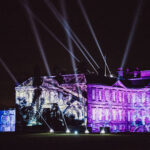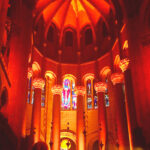YouTube is known for the spontaneous creativity of the artists and fans who post their videos to the site, and it was in that spirit that the inaugural YouTube Music Awards (YTMA) streamed live on Sunday, Nov. 3. The awards honoring the songs and artists that were viral hits globally this year were presented live at Pier 36 in New York City, and the 90-minute show lived up to YouTube’s promise of an untraditional event. Several of the winning artists, including Arcade Fire; Avicii; CDZA; Earl Sweatshirt; Tyler, the Creator; Eminem; Lady Gaga; Lindsey Stirling; and M.I.A., created live music videos on sets placed throughout the venue.
 The festivities moved throughout the entire open space and were hosted by Jason Schwartzman and Reggie Watts, who were not permitted to rehearse prior to the show to maintain the improvisational vibe. The night was conceived by creative director Spike Jonze, in collaboration with co-creative director Chris Milk. They also had several guest directors take charge of the different live music videos, including Damien Kulash; Fafi; James Larese; Joe Sabia; Tyler, the Creator; and Ray Tintori. Jonze rounded out his team by bringing in his longtime production designer K.K. Barrett and director of photography Chris Lavelle.
The festivities moved throughout the entire open space and were hosted by Jason Schwartzman and Reggie Watts, who were not permitted to rehearse prior to the show to maintain the improvisational vibe. The night was conceived by creative director Spike Jonze, in collaboration with co-creative director Chris Milk. They also had several guest directors take charge of the different live music videos, including Damien Kulash; Fafi; James Larese; Joe Sabia; Tyler, the Creator; and Ray Tintori. Jonze rounded out his team by bringing in his longtime production designer K.K. Barrett and director of photography Chris Lavelle.
 Performance Environment Design Group’s (PEDG) Doug “Spike” Brant, along with Justin Collie, handled the event production design and lighting design for the event. Collaborating closely with Jonze and his team, Brant found the experience artistically rewarding. He spoke with PLSN a few days after the event.
Performance Environment Design Group’s (PEDG) Doug “Spike” Brant, along with Justin Collie, handled the event production design and lighting design for the event. Collaborating closely with Jonze and his team, Brant found the experience artistically rewarding. He spoke with PLSN a few days after the event.
PLSN: This was unlike any other event. I imagine it was challenging to design.
 Doug “Spike” Brant: It was a unique and different show, but it went really well. Certainly it was challenging, but that was all part of what made it so great to work on. Also, it was really cool to work with Spike Jonze. You got to be part of inventing a new genre — there were none of the conventional award show approaches. We all worked really hard to bring Spike’s vision to life. The whole concept was about creation; YouTube is all about creating. Instead of just having performances, they wanted to create live music videos. That was the core of Spike’s vision. They wanted to see cameras and roadies; to see the backstage exposed. The idea was that it was very much like being on a soundstage set.
Doug “Spike” Brant: It was a unique and different show, but it went really well. Certainly it was challenging, but that was all part of what made it so great to work on. Also, it was really cool to work with Spike Jonze. You got to be part of inventing a new genre — there were none of the conventional award show approaches. We all worked really hard to bring Spike’s vision to life. The whole concept was about creation; YouTube is all about creating. Instead of just having performances, they wanted to create live music videos. That was the core of Spike’s vision. They wanted to see cameras and roadies; to see the backstage exposed. The idea was that it was very much like being on a soundstage set.
 Your scope of work for PEDG included the lighting design and the overall production design throughout the pier space, correct?
Your scope of work for PEDG included the lighting design and the overall production design throughout the pier space, correct?
Right, though the whole project was a collaboration. Spike brought in K.K. Barrett, his production designer, and we collaborated with him. K.K. is one of the coolest guys I have ever worked with. Spike also brought in Chris Lavelle as the director of photography. They were both great to work with, and we all got along really well. For PEDG, Justin [Collie] was there, along with Felix Peralta [director of programming] and Kevin Lawson [TV lighting programmer]. Also, Laura Frank was the screens director as part of the Control Freak Systems’ team, so we really had an all-star cast working on this. I should also mention George Gountas — he was the gaffer, and he just rocked it.
 The use of the space was unusual for this type of awards event — there wasn’t a traditional stage. Instead, the show used the entire space for the various performances.
The use of the space was unusual for this type of awards event — there wasn’t a traditional stage. Instead, the show used the entire space for the various performances.
Absolutely. There were sets everywhere. Instead of stages, the different acts were on sets to do their live music videos. The room went through a lot of iterations. Every week, we would move sets around; it was constantly changing, and things kept moving. It was crazy up to the last minute as we found out who the confirmed acts were. They wanted a very un-awards show, so in the overall room, there were no motion graphics, and they didn’t want to see any logos.
 How did you approach the lighting to get the coverage you needed throughout the main areas used in the space?
How did you approach the lighting to get the coverage you needed throughout the main areas used in the space?
 For the core room look, they wanted the room to be very simple; they didn’t want any color in it, actually. Between the acts, we would come up into the room look, for which we put a giant softlight in that was 10 by 40 feet because they wanted to have a sort of film feel to it. That was over the awards stage as such, we also hung sky pans for audience light. It was very unconventional; it was cool. We talked concepts with the DP, Chris. We knew they wanted some film crossover in the lighting, so as PEDG, we laid out the room, mainly using our normal tools, then added in the softlights, and we brought in the sky pans to give it that film soundstage feel. When we were shooting the sets, we would black out the room, and nothing mattered but capturing the music video being created on that set. Then, between the sets, we would come up into the generic room look. The key gear I used were shutter lights — the [Vari*Lite] VL3500s and the [Martin] MAC IIIs. Everything in the rig had a function; everything was a workhorse. None of the gear was there to stand out.
For the core room look, they wanted the room to be very simple; they didn’t want any color in it, actually. Between the acts, we would come up into the room look, for which we put a giant softlight in that was 10 by 40 feet because they wanted to have a sort of film feel to it. That was over the awards stage as such, we also hung sky pans for audience light. It was very unconventional; it was cool. We talked concepts with the DP, Chris. We knew they wanted some film crossover in the lighting, so as PEDG, we laid out the room, mainly using our normal tools, then added in the softlights, and we brought in the sky pans to give it that film soundstage feel. When we were shooting the sets, we would black out the room, and nothing mattered but capturing the music video being created on that set. Then, between the sets, we would come up into the generic room look. The key gear I used were shutter lights — the [Vari*Lite] VL3500s and the [Martin] MAC IIIs. Everything in the rig had a function; everything was a workhorse. None of the gear was there to stand out.
 We pre-vized with Early Bird in Lititz [PA], but that wasn’t about programming; it was more about wrapping our head around everything. I have been using previz a lot to move lights around virtually, to avoid extra moving around of lights when you get on site. We really thought about how we had the space laid out, and we found a few holes so we could make a few tweaks. Onsite, we only had to re-hang maybe 10 or 20 lights. Since things kept changing, we knew it meant our needing to be prepared for anything. In the end, it worked out because we used just about everything we put in, so our educated guess was pretty close. We made a lot of the right decisions, based on paying careful attention to how things were evolving and why. It worked and it looked good.
We pre-vized with Early Bird in Lititz [PA], but that wasn’t about programming; it was more about wrapping our head around everything. I have been using previz a lot to move lights around virtually, to avoid extra moving around of lights when you get on site. We really thought about how we had the space laid out, and we found a few holes so we could make a few tweaks. Onsite, we only had to re-hang maybe 10 or 20 lights. Since things kept changing, we knew it meant our needing to be prepared for anything. In the end, it worked out because we used just about everything we put in, so our educated guess was pretty close. We made a lot of the right decisions, based on paying careful attention to how things were evolving and why. It worked and it looked good.
 It worked for the film aspect as well?
It worked for the film aspect as well?
Yes, and I was pleased that we were able to satisfy the film guys with what they needed. It was actually really cool to be able to deliver cueing and adjust the lighting faster than anything they were used to on sets. The quickness with which we were able to crank out cues, adjust the lighting and make tweaks as requested. I think that was critical to allowing Spike to realize his vision. I know Chris was very appreciative and pleased with that. It was fun to be able to do film lighting with live entertainment and television tools.
Any final thoughts about working on this project?
It was awesome, because it was different. Artistically, I don’t need to keep doing a show just like the last show I’ve done. This was definitely different, and it was very collaborative and certainly challenging. All of those things are what made it a cool thing to be involved with. It was so crazy at times, but it was fun working with so many new people and new perspectives. There was a lot of learning going on, which I think is always great. Just a wonderful bunch of people to work with. Like K.K. said at one point — “not a bad egg in the whole group.”
YouTube Music Awards
Crew
Event Production Design and Illumination: Performance Environment Design Group (PEDG)
Producer: Douglas “Spike” Brant
Principal Designer: Justin Collie
Associate Designer: Nathan L. Wilson
Director of Programming/Talent Liaison: Felix Peralta
TV Lighting Programmer: Kevin Lawson
Art Director/Props Master: Ada Smith
Art Director: T. Mark Carroll
Red Carpet/Entry Designer: Andi Blady
Graphic Designer/Assistant to Andi Blady: Sarah Tester
VIP/Hospitality Art Designer: Sara Musselman
Exterior Technical Director: Larry Ganson
Décor Lighting Director: Rob Kerwath
Controller: Michael T. Goodwin
Design Coordinator: Heather Berg
Design Draftsman: Jonathan Hollinger
Executive Assistant/Assistant Design Coordinator: Betsy Arseneau
Production Crew: George Gountas, Gaffer; Rob Kerwath, Outside Gaffer; Alex Flores; David George; David Neel; Stephanie Shechter; Paul Dreher; Greg Goff
Video Screens Director: Laura Frank
Projection Crew (DWP Live): Danny Whetstone, lead projectionist; Justin Sepe, projectionist; Mark Clements, video utility tech
Video Control Crew (Control Freak Systems) Dirk Sanders, Stuart White, Kirk Miller, Kevin Cauley, Ryan Middlemiss, Troy Giddens
Scenic Equipment: Atomic Scenic
Gear
Lighting (from Atomic Lighting)
135 Elation QA PARs
40 Vari*Lite VL3500 Spots
35 Vari*Lite VL3000 Spots
60 Vari*Lite VL2500 Spots
36 Clay Paky Sharpy Washes
24 Clay Paky Sharpys
24 GLP impression X4s
20 Martin MAC 301s
28 Martin MAC 2000 XBs
12 Martin MAC III Performances
24 Martin Atomic Strobes
5 Robert Juliat Ivanhoe followspots
300 Philips Color Kinetics TRXs
20 Color Kinetics iWhites
55 Chroma-Q Color Force 72s
15 Chroma-Q Color Force 48s
10 Nook Lites
25 2kW Sky Pans
2 6kW Space Lights
25 Kino Flo Image 88s
15 Kino Flo 4’ singles
4 Litepanels Bi-Color Litepanels
20 ARRI 1.2kW HMI PARs
2 ARRI 750W Open Face Kits
2 Joker 400W HMI Bugs
Chimeras
1-Ton Grip Truck
Projection Gear (from DWP Live)
9 Barco HDX W18 Projectors
4 Barco HDF W26 Projectors
2 Barco FLM HD20 Projectors
2 Draper Stage Screen 13.5’x24’screens
1 Draper Stage Screen 11.25’x20’screens
8 Sharp Aquos 80” LED Monitors
21 BR-15 LED Tiles
Video Control (from Control Freak Systems)
16 PRG Mbox Extreme media servers
4 MA Lighting grandMA consoles
9 Barco Encore processors
2 CFS Freakulizers (real-time virtual show environment)
1 CFS lighting previz system
2 CFS Encore Bridge Controllers
3 Apple Mac Minis
1 PC Laptop video processor configuration


